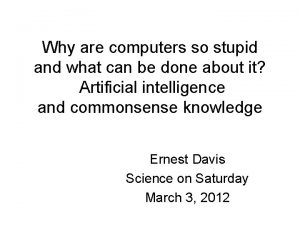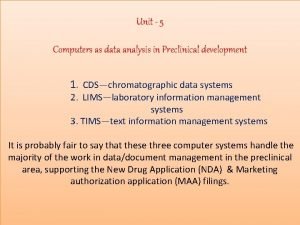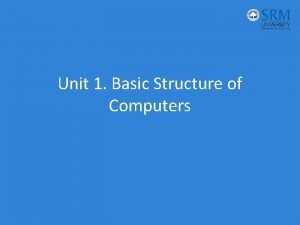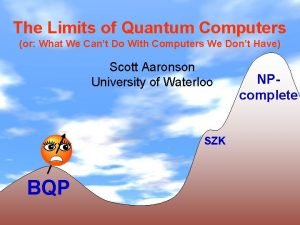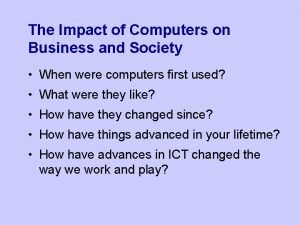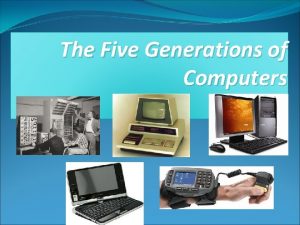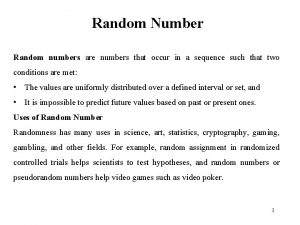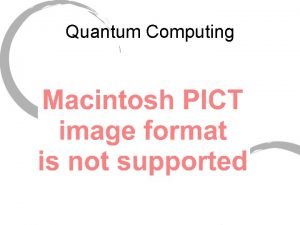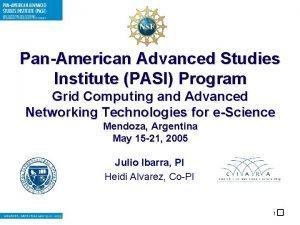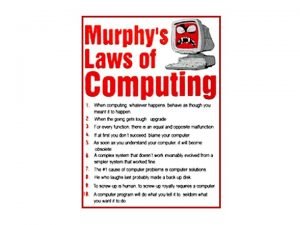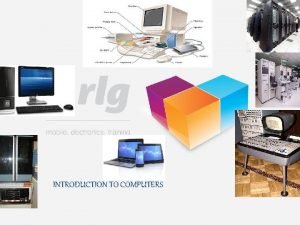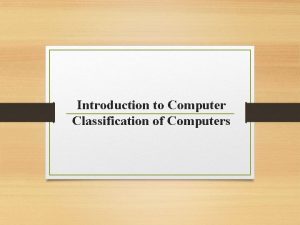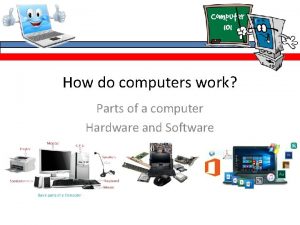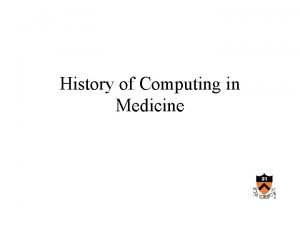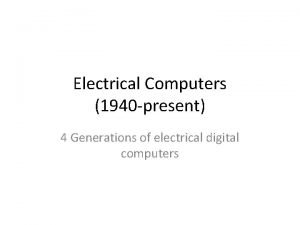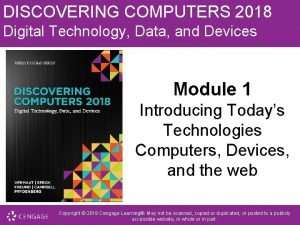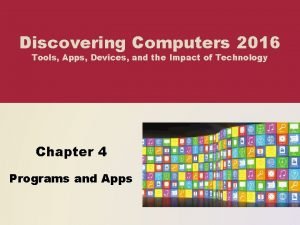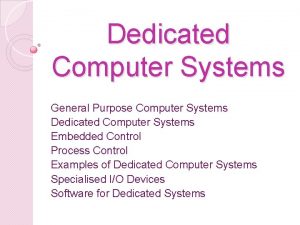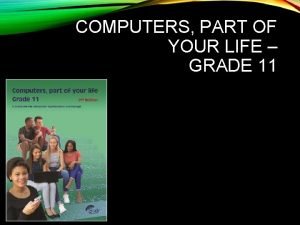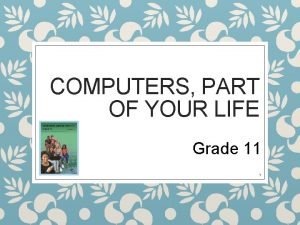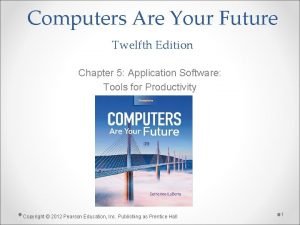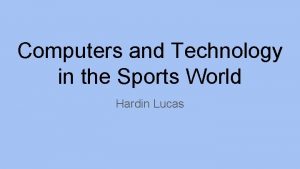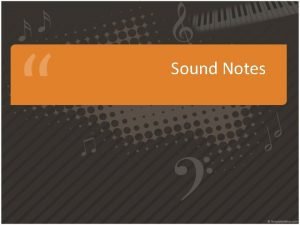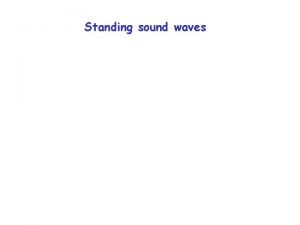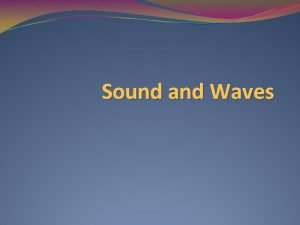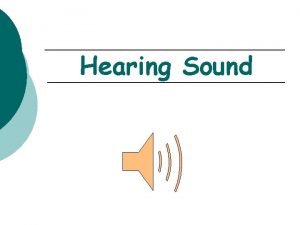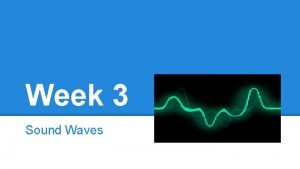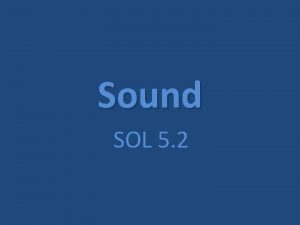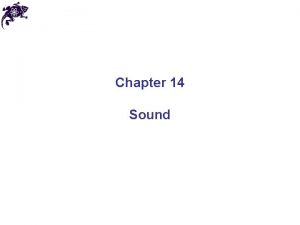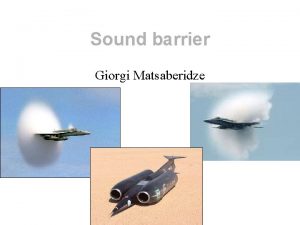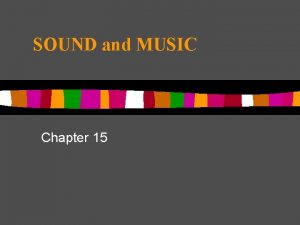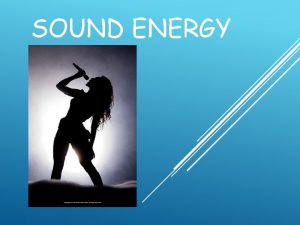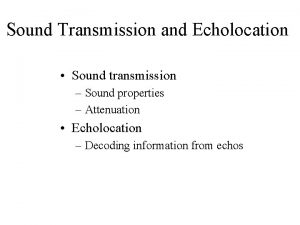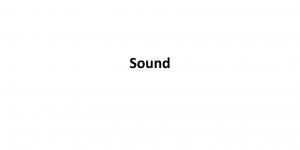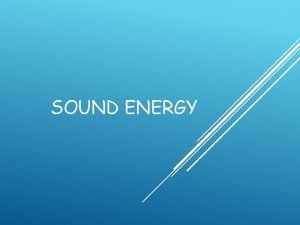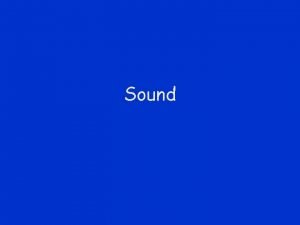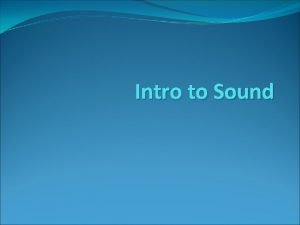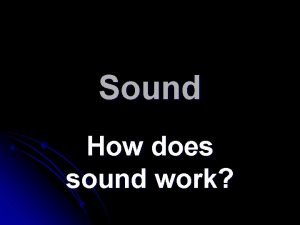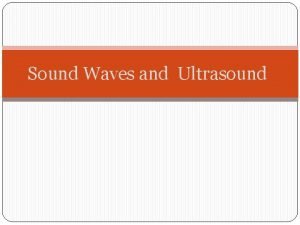6 SoundAudio How computers process sound How computers





























- Slides: 29

6. Sound/Audio

§ § § How computers process sound How computers synthesize sound The differences between the two major kinds of audio, namely digitised sound and MIDI music 2

The Nature of Sound § Sound is a physical phenomenon produced by the vibration of matter and transmitted as waves. § However, the perception of sound by human beings is a very complex process. It involves three systems: - the source which emits sound; - the medium through which the sound propagates; - the detector which receives and interprets the sound. 3

§ Sounds we heard everyday are very complex. Every sound is comprised of waves of many different frequencies and shapes. But the simplest sound we can hear is a sine wave. § Sound waves can be characterised by the following attributes: Period, Frequency, Amplitude, Bandwidth, Pitch, Loudness, Dynamic. 4

Pitch and Frequency § Period is the interval at which a periodic signal repeats regularly. § Pitch is a perception of sound by human beings. It measures how ‘high’ is the sound as it is perceived by a listener. § Frequency measures a physical property of a wave. It is the reciprocal value of period f = 1/P. § The unit is Herts (Hz) or kilo. Hertz (k. Hz). § § § Infra-sound 0 – 20 Hz Human hearing range 20 – 20 k. Hz Ultrasound 20 k. Hz – 1 GHz Hypersound 1 GHz – 10 THz Musical instruments are tuned to produce a set of fixed pitches. 5

Loudness and Amplitude § The other important perceptual quality is loudness or volume. § Amplitude is the measure of sound levels. For a digital sound, amplitude is the sample value. § The reason that sounds have different loudness is that they carry different amount of power. § The unit of power is watt. The intensity of sound is the amount of power transmitted through an area of 1 m 2 oriented perpendicular to the propagation direction of the sound. § If the intensity of a sound is 1 watt/m 2, we may start feel the sound. The ear may be damaged. 6

§ This is known as the threshold of feeling. If the intensity is 10 -12 watt/m 2, we may just be able to hear it. This is know as the threshold of hearing. § The relative intensity of two different sounds is measured using the unit Bel or more commonly deci. Bel (d. B). It is defined by relative intensity in d. B = 10 log(I 2/I 1) § Very often, we will compare a sound with the threshold of hearing. 7

§ § § § 160 d. B Jet engine 130 d. B Large orchestra at fortissimo 100 d. B Car on highway 70 d. B Voice conversation 50 d. B Quiet residential areas 30 d. B Very soft whisper 20 d. B Sound studio 8

Dynamic and Bandwidth § Dynamic range means the change in sound levels. § For example, a large orchestra can reach 130 d. B at its climax and drop to as low as 30 d. B at its softest, giving a range of 100 d. B. § Bandwidth is the range of frequencies a device can produce, or a human can hear e. g. FM radio: Children’s ears: Older ears: 50 Hz – 15 k. Hz 20 Hz – 20 k. Hz 50 Hz – 10 k. Hz . 9

Computer Representation of Sound § Sound waves are continuous while computers are good at handling discrete numbers. § In order to store a sound wave in a computer, samples of the wave are taken. § Each sample is represented by a number, the ‘code’. § This process is known as digitisation. § This method of digitising sound is know as pulse code modulation (PCM). 10

§ According to Nyquist sampling theorem, in order to capture all audible frequency components of a sound, i. e. , up to 20 k. Hz, we need to set the sampling to at least twice of this. This is why one of the most popular sampling rate for high quality sound is 4410 Hz. § Another aspect we need to consider is the resolution, i. e. , the number of bits used to represent a sample. § Often, 16 bits are used for each sample in high quality sound. This gives the SNR of 96 d. B. 11

Quality versus File Size § The size of a digital recording depends on the sampling rate, resolution and number of channels. § S = R x (b/8) x C x D § Higher sampling rate, higher resolution gives higher quality but bigger file size. § § § S file size R sampling rate b resolution C channels D recording duration bytes samples per second bits 1 - mono, 2 - stereo seconds 12

§ For example, if we record 10 seconds of stereo music at 44. 1 k. Hz, 16 bits, the size will be: § S = 44100 x (16/8) x 2 x 10 = 1, 764, 000 bytes = 1722. 7 Kbytes = 1. 68 Mbytes Note: 1 Kbytes = 1024 bytes 1 Mbytes = 1024 Kbytes § High quality sound files are very big, however, the file size can be reduced by compression. 13

Audio File Formats The most commonly used digital sound format in Windows systems is. wav files. § Sound is stored in. wav as digital samples known as Pulse Code Modulation(PCM). § Each. wav file has a header containing information of the file. – – – type of format, e. g. , PCM or other modulations size of the data number of channels samples per second bytes per sample § There is usually no compression in. wav files. Other format may use different compression technique to reduce file size. §. vox use Adaptive Delta Pulse Code Modulation (ADPCM). §. mp 3 MPEG-1 layer 3 audio. § Real. Audio file is a proprietary format. 14

Audio Hardware Recording and Digitising sound: § An analogue-to-digital converter (ADC) converts the analogue sound signal into digital samples. § A digital signal processor (DSP) processes the sample, e. g. filtering, modulation, compression, and so on. Play back sound: § A digital signal processor processes the sample, e. g. decompression, demodulation, and so on. § A digital-to-analogue converter (DAC) converts the digital samples into sound signal. 15

§ All these hardware devices are integrated into a few chips on a sound card. § Different sound card have different capability of processing digital sounds. When buying a sound card, you should look at: – maximum sampling rate – stereo or mono – duplex or simplex 16

Audio Software § Windows device driver — controls the hardware device. Many popular sound cards are Plus and Play. Windows has drivers for them and can recognise them automatically. For cards that Windows does not have drivers, you need to get the driver from the manufacturer and install it with the card. § If you do not hear sound, you should check the settings, such as interrupt, DMA channels, and so on. § Device manager — the user interface to the hardware for configuring the devices. § You can choose which audio device you want to use § You can set the audio volume 17

Mixer — its functions are: § to combine sound from different sources § to adjust the play back volume of sound sources § to adjust the recording volume of sound sources Recording — Windows has a simple Sound Recorder. Editing — The Windows Sound Recorder has a limiting editing function, such as changing volume and speed, deleting part of the sound. There are many freeware and shareware programs for sound recording, editing and processing. 18

Computer Music - MIDI § Sound waves, whether occurred natural or manmade, are often very complex, i. e. , they consist of many frequencies. Digital sound is relatively straight forward to record complex sound. However, it is quite difficult to generate (or synthesize) complex sound. § There is a better way to generate high quality music. This is known as MIDI — Musical Instrument Digital Interface. 19

MIDI § It is a communication standard developed in the early 1980 s for electronic instruments and computers. It specifies the hardware connection between equipments as well as the format in which the data are transferred between the equipments. § Common MIDI devices include electronic music synthesisers, modules, and MIDI devices in common sound cards. § General MIDI is a standard specified by MIDI Manufacturers Association. To be GM compatible, a sound generating device must meet the General MIDI system level 1 performance requirement. 20

MIDI files When using computers to play MIDI music, the MIDI data are often stored in MIDI files. Each MIDI files contains a number of chunks. There are two types of chunks: § Header chunk — contains information about the entire file: the type of MIDI file, number of tracks and the timing. § Track chunk — the actual data of MIDI track. There three types of MIDI file: § 0 single multi-channel track § 1 one or more simultaneous track of a sequence § 2 one or more sequentially independent single-track patterns 21

Tracks, channels and patches § Multiple tracks can be played at the same time. § Each track can be assigned to a different channel. § Each channel can accept more than one track. § Each channel is assigned a patch, therefore generates sound of a particular instrument. 22

How MIDI Sounds Are Synthesized A simplistic view is that: § the MIDI device stores the characteristics of sounds produced by different sound sources; § the MIDI messages tell the device which kind of sound, at which pitch is to be generated, how long the sound is played and other attributes the note should have. 23

There are two ways of synthesizing sounds: § FM Synthesis (Frequency Modulation)—Using one sine wave to modulate another sine wave, thus generating a new wave which is rich in timbre. It consists of the two original waves, their sum and difference and harmonics. The drawbacks of FM synthesis are: the generated sound is not real; there is no exact formula for generating a particular sound. § Wave-table synthesis— It stores representative digital sound samples. It manipulates these samples, e. g. , by changing the pitch, to create the complete range of notes. 24

MIDI Sound Attributes § The shape of the amplitude envelop has great influence on the resulting character of sound. There are two different types of envelop: § Diminishing sound — gradually die out; § Continuing sound — sustain until turned off. 25

The Amplitude Envelop § Delay — the time between when a key is played and when the attack phase begins § Attack — the time from no sound to maximum amplitude § Hold—the time envelop will stay at the peak even before starting the decay phase § Decay — the time it takes the envelop to go from the peak level to the sustain level § Sustain — the level at which the envelop remains as long as a key is held down § Release — the time is takes for the sound to fade to nothing 26

MIDI software MIDI player for playing MIDI music. This includes: § Windows media player can play MIDI files § Player come with sound card— Creative Midi player § Freeware and shareware players and plug-ins—Midigate, Yamaha Midplug, etc. MIDI sequencer for recording, editing and playing MIDI § Cakewalk Express, Home Studio, Professional § Cubasis § Encore § Voyetra MIDI Orchestrator Plus Configuration — Like audio devices, MIDI devices require a driver. Select and configure MIDI devices from the control panel. 27

Summary - MIDI versus Digital Audio § Digital representation of physical sound waves § File size is large if without compression § Quality is in proportion to file size § More software available § Play back quality less dependent on the sound sources § Can record and play back any sound including speech 28

MIDI § Abstract representation of musical sounds and sound effects § MIDI files are much more compact § File size is independent to the quality § Much better sound if the sound source is of high quality § Need some music theory § Cannot generate speech 29
 “a sound mind is in a sound body”
“a sound mind is in a sound body” Louder sound wave
Louder sound wave Computers are stupid
Computers are stupid In preclinical development which softwares are used
In preclinical development which softwares are used Basic structure of a computer
Basic structure of a computer Computer science ucl
Computer science ucl Computers make the world smaller and smarter answers
Computers make the world smaller and smarter answers The limits of quantum computers
The limits of quantum computers Impact of computer on business
Impact of computer on business The five generations of computers
The five generations of computers How do computers get random numbers
How do computers get random numbers Quantum binary
Quantum binary Panamerica computers
Panamerica computers Murphy's computer law
Murphy's computer law Example of input device
Example of input device Classification of computers
Classification of computers Advantages and disadvantages of speed networking
Advantages and disadvantages of speed networking How do computers work
How do computers work 1950s computers
1950s computers Copyright
Copyright Eniac full form in computer
Eniac full form in computer Discovering computers 2018 ppt download
Discovering computers 2018 ppt download Discovering computers 2016
Discovering computers 2016 Erfinderin des kaffeefilters
Erfinderin des kaffeefilters Examples of dedicated systems
Examples of dedicated systems Computers part of your life grade 11
Computers part of your life grade 11 Computers part of your life grade 11 memo
Computers part of your life grade 11 memo Computers are your future 12th edition pdf
Computers are your future 12th edition pdf Computers are amazing
Computers are amazing Hardin computers
Hardin computers


